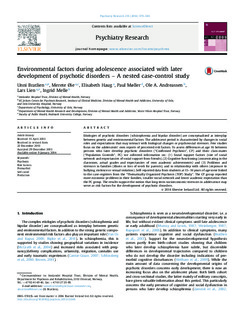| dc.description.abstract | Etiologies of psychotic disorders (schizophrenia and bipolar disorder) are conceptualized as interplay between genetic and environmental factors. The adolescent period is characterized by changes in social roles and expectations that may interact with biological changes or psychosocial stressors. Few studies focus on the adolescents’ own reports of perceived risk factors. To assess differences at age 16 between persons who later develop psychotic disorders (“Confirmed Psychosis”, CP) and their class-mates (“Population Controls”, PC) we collected information on: (1) Social support factors (size of social network and expectancies of social support from friends), (2) Cognitive functioning (concentrating in the classroom, actual grades and expectancies of own academic achievements) and (3) Problems and stressors in families (illness or loss of work for parents), and in relationship with others (exposure to bullying, violence or sexual violation). Self-reported data from students at 15–16 years of age were linked to the case-registers from the “Thematically Organized Psychosis (TOP) Study”. The CP group reported more economic problems in their families, smaller social network and lower academic expectation than the PC group. The results support the notion that long-term socioeconomic stressors in adolescence may serve as risk factors for the development of psychotic disorders | |
